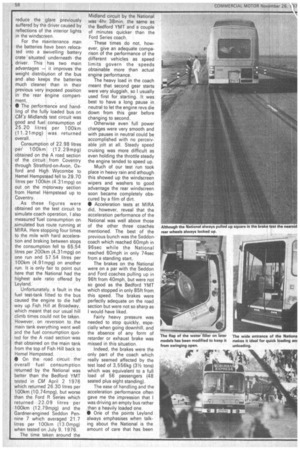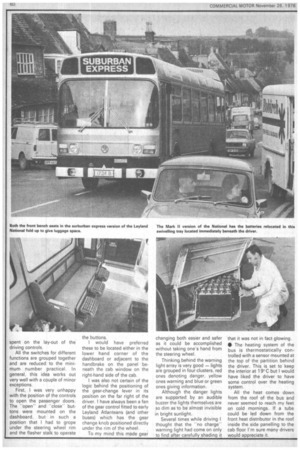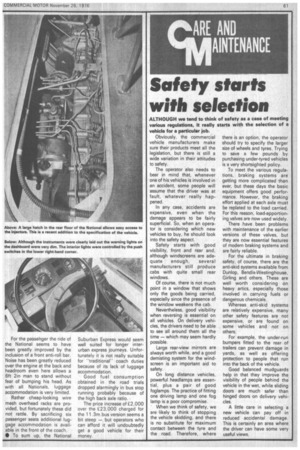A silvery ride...
Page 59

Page 60

Page 62

Page 63

If you've noticed an error in this article please click here to report it so we can fix it.
Martin Watkins road tests the Leyland National 'Suburban Express'. Dick Ross took the photos
With just 2,000 miles on the clock this vehicle is only just "run-in" and is intended for service with Western Welsh after Christmas. The bus had the top power engine option available from Leyland, the 149.1kW (200bhp) engine running at 2,200rpm. Maximum torque of this unit is 779.6Nm (575Ib ft) at 1,40Orpm.
All three power options available use the Leyland 510 fixed-head engine horizontally located at the rear. The engine of the test bus was matched to the five-speed SCG semi-automatic gearbox.
• The National had always undoubtedly been a "driver's vehicle.' but the recent models have been aimed at giving better passenger comfort and also to ease the lot of the maintenance man.
The bus tested was a "Phase twomodel first introduced earlier this year. These vehicles have the partition at the front of the passenger compartment integrated into the main vehicle structure to increase the body torsional rigidity and to prevent the body shake previously associated with Nationals.
Action has also been taken to continued overleaf reduce the glare previously suffered by the driver caused by reflections of the interior lights in the windscrleen.
For the maintenance man the batteries have been relocated into a swivelling battery crate situated underneath the driver. This has two main advantages — it improves the weight distribution of the bus and also keeps the batteries much cleaner than in their previous very exposed position in the rear engine compartment.
• The performance and handling of the fully loaded bus on CM's Midlands test circuit was good and fuel' consumption of 25.20 litres per 100km (11.21mpg) was returned overall.
ConsumptioI-i of 22.98 litres per 100km (12.29mpg) obtained on the A road section of the circuit from Coventry through Stratfdrd-on-Avon, Oxford and High Wycombe to Hemel Hempstead fell to 29.70 litres per 1007 (4.31mpq) on out on the m torway section from Hemel Hempstead up to Coventry.
As these figures were obtained on the test circuit to simulate coach operation, I also measured fuel consumption on. simulated bus route running at MIRA. Here stopping four times to the mile with hard acceleration and braking between stops the consumption fell to 65.54 litres per 200km (4.31mpg) on one run and 57.54 litres per 100km (4.91mpg) on another run. It is only fair to point out here that the National had the highest axle ratio offered by Leyland.
Unfortunately, a fault in the fuel test-tank fitted to the bus caused the engine to die half way up Fish Hill at Broadway, which meant that our usual hill climb times could not be taken. However, on reversion to the main tank everything went well and the fuel consumption quoted for the A road section was that obtained on the main tank from the top of Fish Hill back to Hemel Hempstead.
• On the road circuit the' overall fuel consumption returned by the National was better than the Bedford YMT tested in CM April 2 1976 which returned 26.30 litres per 100km (10.74mpg), but worse than the Ford R Series which returned 22.09 litres per 100km (12.79mpg) and the Gardner-engined Seddon Pennine 7 which averaged 21.7 litres per 100km (13.0n-ipg) when tested on July 9, 1976.
The time taken around the Midland circuit by the National was 4hr 38min, the same as the Bedford YMT and a couple of minutes quicker than the Ford Series coach.
These times do not, however, give an adequate compa rison of the performance of the different vehicles as speed limits govern the speeds obtainable more than actual engine performance.
The heavy load in the coach meant that second gear starts were very sluggish, so I usually used first for starting. It was best to have a long pause in neutral to let the engine revs die down from this gear before changing to second.
Otherwise even full power changes were very smooth and with pauses in neutral could be accomplished with no perceivable jolt at all. Steady speed cruising was more difficult as even holding the throttle steady the engine tended to speed up.
Much of our test run took place in heavy rain and athough this showed up the windscreen wipers and washers to good advantage the rear windscreen soon became completely obscured by a film of dirt_ • Acceleration tests at MIRA did, however, reveal that the acceleration performance of the National was well above those of the other three coaches mentioned. The best of the previous bunch was the Seddon coach which reached 60mph in 96sec while the National reached 60mph in only 74sec from a standing start.
The brakes on the National were on a par with the Seddon and Ford coaches pulling up in 96ft from 40mph, but were not so good as the Bedford YMT which stopped in only 85ft from this speed. The brakes were perfectly adequate on the road section but were not so sharp as I would have liked.
Fairly heavy pressure was needed to stop quickly, especially when going downhill, and the absence of any form of retarder or exhaust brake was missed in this situation.
Indeed, the brakes were the only part of the coach which really seemed affected by the test load of 3,556kg (31/2 tons) which was equivalent to a full load of 56 passengers (48 seated plus eight standing).
The ease of handling and the acceleration performance often gave me the impression that I was driving an empty bus rather than a heavily loaded one • One of the points Leyland always emphasises when talking about the National is the amount of care that has been spent on the lay-out of the driving controls.
All the switches for different functions are grouped together and are reduced to the minimum number practical. In general, this idea works out very well with a couple of minor exceptions.
First, I was very unhappy with the position of the controls to open the passenger doors. The "open" and "closebuttons were mounted on the dashboard, but in such a position that I had to grope under the steering wheel rim and the flasher stalk to operate
the buttons.
I would have preferred these to be located either in the lower hand corner of the dashboard or adjacent to the handbrake on the panel beneath the cab window on the right-hand side of the cab.
I was also not certain of the logic behind the positioning of the gear-change lever in its position on the far right of the driver. I have always been a fan of the gear control fitted to early Leyland Atlanteans (and other buses) which has the gear change knob positioned directly under the rim of the wheel.
To my mind this made gear changing both easier and safer as it could be accomplished without taking one's hand from the steering wheel.
Thinking behind the warning light-array is very good — lights are grouped in four clusters, red ones denoting danger, yellow ones warning and blue or green ones giving information.
Although the danger lights are supported by an audible buzzer the lights themselves are so dim as to be almost invisible in bright sunlight.
Several times while driving I thought that the "no charge" warning light had come on only to find after carefully shading it that it was not in fact glowing.
• The heating system of the bus is thermostatically controlled with a sensor mounted at the top of the partition behind the driver. This is set to keep the interior at 19"C but I would have liked the driver to have some control over the heating system.
All the heat comes down from the roof of the bus and never seemed to reach my feet on cold mornings. If a tube could be led down from the front heat distributor in the roof inside the side panelling to the cab floor I'm sure many drivers would appreciate it. For the passenger the ride of the National seems to have been greatly improved by the inclusion of a front anti-roll bar. Noise has been greatly reduced over the engine at the back and headroom even here allows a 6ft 2in man to stand without fear of bumping his head. As with all Nationals, luggage accommodation is very limited.
Rather cheap-looking wire mesh overhead racks are provided, but fortunately these did not rattle. By sacrificing six passenger seats additional luggage accommodation is available in the front of the coach.
• To sum up, the National Suburban Express would seem well suited for longer interurban express journeys. Unfortunately it is not really suitable for "traditional" coach duties because of its lack of luggage accommodation.
Good fuel consumption obtained in the road trials dropped alarmingly in bus stop running probably because of the high back axle ratio.
The price increase of E2,000 over the £23,000 charged for the 11 3m bus version seems a bit steep —. but operators who can afford it will undoubtedly get a good vehicle for their money.








































































































